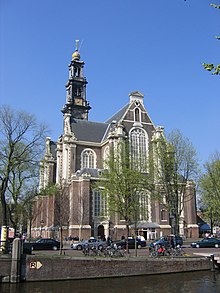Westerkerk
| Westerkerk | |
|---|---|

Westerkerk in 2005
|
|
| Basic information | |
| Location | Prinsengracht 281,Amsterdam, Netherlands |
| Geographic coordinates | 52°22′28″N 4°53′1″E / 52.37444°N 4.88361°ECoordinates: 52°22′28″N 4°53′1″E / 52.37444°N 4.88361°E |
| Affiliation | Protestant Church in the Netherlands |
| Rite | Protestant Reformed |
| Ecclesiastical or organizational status | Parish church |
| Website | www.westerkerk.nl |
| Architectural description | |
| Architect(s) | Hendrick de Keyser |
| Architectural style | Dutch Renaissance |
| Completed | 1631 |
Westerkerk (Dutch pronunciation: [ʋɛstərkɛrk]; English: Western Church) is a Reformed church within Dutch Protestant church in central Amsterdam in the Netherlands. It is next to Amsterdam's Jordaan district, on the bank of the Prinsengracht canal.
The 'Westerkerk' was built between 1620 and 1631 in Renaissance style, built according to designs by architect Hendrick de Keyser (1565-1621). He is buried in the church he designed earlier: the 'Zuiderkerk'. The building of the Westerkerk was finished and completed by his son Pieter de Keyser (1595-1676) and inaugurated on June 8, 1631. The church has a length of 58 meters and a width of 29 meters. The high nave is flanked by the two lower aisles. The three-aisled basilica has a rectangular plan with two transepts of equal dimensions. As a result, the plan for this church was given the form of two Greek crosses connected with each other. (a patriarchal cross).
Several older churches in Amsterdam, such as Oude Kerk and Nieuwe Kerk, were originally built before the Reformation and were converted to Protestantism during the Reformation in 1578. The Westerkerk was one of the first purposely built Protestant churches. The Noorderkerk and Zuiderkerk preceded the Westerkerk. Today the Westerkerk remains the largest church in the Netherlands that was built for Protestants, and is still in use by the PKN (Protestantse Kerk in Nederland)
There was no organ when the Westerkerk was consecrated on Whit Sunday the 8th of June in 1631. According to Calvinism, playing instrumental music inside the church was still considered 'profane' in those days. It took many years of consultation until an organ was finally allowed. At first there was still talk of moving the small organ (koororgel) used in the Nieuwe- or the 'Oudekerk' but the pipes of this 'Oudekerk' choir organ were finally moved to the 'Zuiderkerk'. In 1681 the Westerkerk decided on commissioning organ builder Roelof Barentszn Duyschot for the construction of a new organ. Before it was finished he died and in 1686 the new organ was finished by his son Johannes Duyschot. Later in 1727 it was enlarged with an extra third keyboard by Christiaan Vater who learned his profession at Arp Schnitger.
...
Wikipedia
